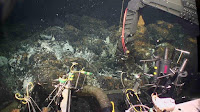By Rachel Teasdale
Weather
Bright but overcast skies with calm wind (approximately 10 knots) and calm seas.
What’s happening today?
Last night the last ROV Jason dive of the cruise ended by looking at 2015 lavas of the NRZ at midnight. We’re currently in transit back to Seattle, with an expected arrival at the University of Washington dock at 10 AM Saturday August 29.
 |
| Bathymetric map of Axial Caldera and hydrothermal vent fields visited during dive J2-825. |
J2-825
Following the successful of the pressure dives (J2-823 and 824) and a quick turnaround by the Jason crew, dive J2-825 was launched Wednesday morning at the Marker 33 Vent in the southeast part of the caldera. This vent has been active since before the 1998 eruption and vent samples have been collected there nearly continuously, making it one of the best time-series sites in the caldera. Fluid samples were collected for the second round of incubator experiments and for chemical analysis and microbial culturing on the ship.
 |
| Sampling fluids at Marker 33 Vent for the second incubator experiments during dive J2-825. |
Following the fluid sampling, Jason transited to the NE caldera rim where we explored more of the 2015 lava flows that we had not yet seen or sampled. We targeted this area because some of the earlier CTD tow-yos above NE rim of the caldera (see CTD blog) had revealed high turbidity and multi-layered hydrothermal plumes above the seafloor, suggesting that 2015 lavas, or perhaps new hydrothermal vents, were emitting vent fluids. We spent several hours exploring the NE caldera rim and sampling the 2015 lava flows along the North Rift Zone (NRZ).
| Jumbled surface (left) and ropy surface (right) on 2015 lava flows on the NE caldera rim (J2-825). | |
| Collapsed areas of 2015 lava flows (J2-825). | |
| Pillow lavas (left) and a pillow bud collected from 2015 lava flows (J2-825). | |
J2-826
 |
| RAS vent fluid sampler installed at a vent on Axial’s North Rift Zone (J2-826). |
The first task during the dive was to position the Remote Access Sampler (RAS), which is a set of water bottles that will collect vent fluid samples in a time-series over a year when the RAS will be recovered. The RAS was deployed from the ship earlier today by placing it in the water and letting it free-fall to the seafloor with weights that increase its descent rate and remain on the seafloor. On recovery, Jason will return to manually release the anchor attached to the RAS so that glass floats attached above the RAS can lift it back to the surface.
 |
| Bathymetric map of Axial North Rift zone showing exploration waypoints for dive J2-826. Only the southern half of the waypoints were visited before the dive ended. |
 |
| Suction sampler collecting orange bacterial mat from a site called “snow drift” on the 2015 lavas. The two red laser dots are 10 cm apart (J2-826). |
We continued exploring the 2015 lavas of the NRZ as long as we could before it was time to recover Jason and head for home. As usual, there is always more we would like to do if we had more time, but that’s what also keeps us coming back to Axial Seamount! We headed to the surface with lots of samples and a much better idea of the diversity and distribution of the 2015 lava flows than we started with. Next stop, Seattle!
 |
| Last view of 2015 lavas of the NRZ as Jason departed for the surface (J2-826). |





